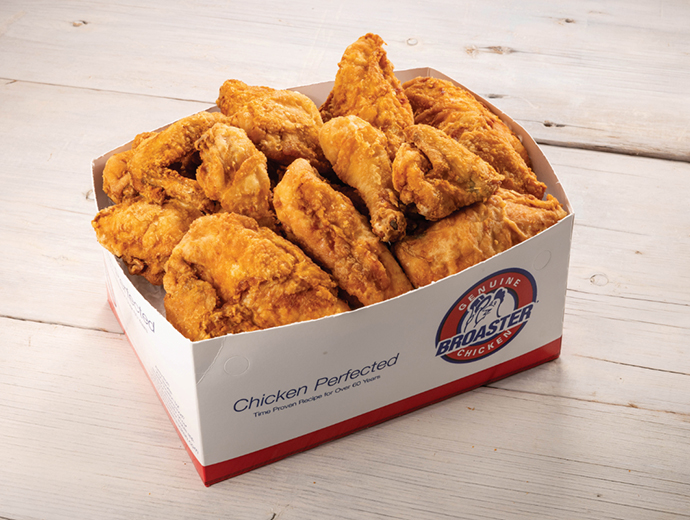Broaster Buzz

Tailoring fried chicken programs for success amid pandemic
 KANSAS CITY, MO. – Since coronavirus (COVID-19) rattled the country, consumers have been turning to comfort foods like fried chicken, leaving plenty of room for grocers to play up their fried chicken program offerings with a few adjustments to fit into the post-COVID-19 world.
KANSAS CITY, MO. – Since coronavirus (COVID-19) rattled the country, consumers have been turning to comfort foods like fried chicken, leaving plenty of room for grocers to play up their fried chicken program offerings with a few adjustments to fit into the post-COVID-19 world.
Packaging solutions
Reinforcing takeout and delivery strategies amid COVID-19 isn’t only important for restaurants, it’s vital for grocery prepared foods programs like fried chicken, too. But greasy, crisp, fried foods like fried chicken provide an extra packaging challenge. In order for grocers to market fried chicken in a grab-and-go context, packaging that keeps meals like an eight-piece prepared package of fried chicken fresh, crisp and hot is going to be key.

Ballwin, Mo.-based Anchor Packaging recognizes that packaging for hot to-go foods should have the following features:
- Leak-resistant, with tight closure to avoid messy spills en route
- Special features to keep fried foods, both hot and crisp
- Re-closable bases and lids made with dishwasher-safe, reusable materials
- The ability to withstand temperatures to 230 degrees Fahrenheit under a heat lamp or in the microwave
- Capable of consumer reuse and recycled after multiple uses
Foam and paper packaging rarely meets those critical characteristics, so the packaging company recommends using rigid, polypropylene plastic containers, with hinged or separate bases and lids that in the least provide performance and protection needed to deliver taste profiles comparable to what a customer might enjoy if they would sit down and eat the meal straight after ordering it from the deli counter.
Fried hot foods like fried chicken need packaging that meets those aspects and beyond. That’s why Anchor introduced its line of Crisp Food Technologies containers designed to keep food hot and crispy.

“The line of Crisp Food Technologies containers were developed to keep fried chicken hot and crisp in supermarket displays for up to four hours,” said Marilyn Stapleton, director of marketing for Anchor. “Crisp Food Technologies, combined with Nature’s Best Roasters, are perfect for hot-to-go deli offerings for the store shopper or online orders for curbside pick-up and home delivery. Consumers may be more aware of the high-quality prepared foods available in the deli during the COVID-19 crisis, and merchandisers should take advantage of promoting their no-wait packaged hot meal solutions. Advertising hot meal options in grocery loyalty programs will remind consumers to continue to consider the store as a source for their ready-to-eat meals.”
Available in hinged and separate lid-base options, the crisp food containers maintain the taste of fried entrees and sides using a patented convection cross-flow design that relieves moisture and condensation while maintaining food temperature.
Earlier this year, Anchor added to the line with the launch of Fry Baby, a clear, hinged container specifically intended to hold fried chicken strips and other fried side items. The new packaging option is the lowest-priced container in the Crisp Food Technologies line and costs less than some paper containers. The aspect of clear packaging is also vital in merchandising the look of a fresh meal to consumers.
Branded programs
 With the mission-driven shopping habits of post-COVID-19 consumers, it’s more important than ever to remind shoppers that fresh, ready-to-eat food like fried chicken is available to pick up and take home for an easy family meal. Branded friend chicken programs such as Genuine Broaster Chicken is especially beneficial when it comes to merchandising to customers.
With the mission-driven shopping habits of post-COVID-19 consumers, it’s more important than ever to remind shoppers that fresh, ready-to-eat food like fried chicken is available to pick up and take home for an easy family meal. Branded friend chicken programs such as Genuine Broaster Chicken is especially beneficial when it comes to merchandising to customers.
Beloit, Wis.-based Broaster Company can partner with retailers to introduce its Genuine Broaster Fried Chicken trademark program. Under the program, grocers can brand their fried chicken with Broaster’s trademark if the retailer uses at least one of Broaster Company’s pressure fryers, uses the brand’s marinades, follows the brand’s cooking procedures and presents the brand appropriately.
Under the Broaster trademark, retailers can choose to use just Broaster’s signature chicken and offer customers their own sides or they can choose to go through Broaster for both chicken and sides. Retailers can also choose to customize their own program using their own selection of Broaster seasonings, marinades, equipment and sides, but under this option a retailer would have to use their own private label for the program.
Going through Broaster’s program gives retailers access to the company’s trademark branding. At minimum, retailers will be provided with the Broaster Chicken logo and graphic art that a grocer can feed into its existing programs. Or Broaster can work with retailers to provide menu boards. It’s incredibly important that the fried chicken products look good and have a clear variety of food combinations which will draw in consumers, said Greg West, Broaster’s senior vice president of marketing and food innovation.
“A lot of it’s about the presentation,” West said. “So, if mom or dad is looking for a meal solution and they have three screaming kids with them, they have the ability to see in the deli aisle that they can get 12 pieces of chicken, two sides and rolls for $19.99.”
Retailers also have the option of purchasing equipment from Broaster without participating in the chicken program. But if a retailer goes that route, they won’t have the option to use Broaster’s merchandising tools.
For the entire story from the July 2020 issue of Supermarket Perimeter, click here.
Program Details
Bringing America’s Favorite Chicken to your customers is easy and profitable. Click to discover more details about our licensed trademark operator program.
LEARN MORE




